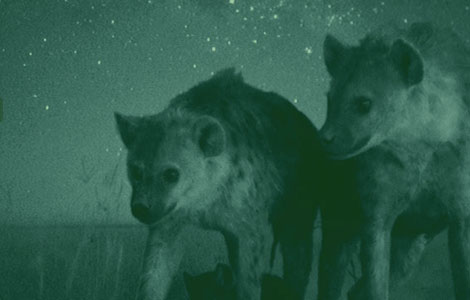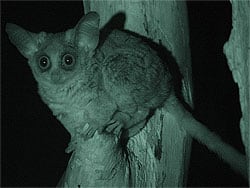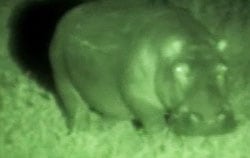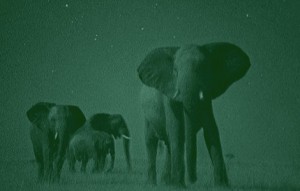Using Night Vision Binoculars on Safari

I used to work as a safari guide (field guide) in South Africa and that is where my interest in binoculars first begun. During that time, I never actually owned a pair of night vision binoculars or indeed any other night vision device, simply because back then they were much more expensive to buy and definitely more than I could afford on my guiding salary. I did however on quite a few occasions have the opportunity to use a pair that a guest had brought with them, but this was a real treat.
Thankfully these days, with more and more manufacturers producing them, the increased competition has meant that the price of night vision devices has come down significantly and I would say that in general as the technology has improved, so has the quality.
 Earlier this year I was given the opportunity to take a pair of Luna Optics LN-PB3 Night vision binoculars with me on a safari holiday to Zimbabwe. I used them a lot and thought that they were truly excellent as they gave me many memories and talking points that I would not have even known about had I not had them with me.
Earlier this year I was given the opportunity to take a pair of Luna Optics LN-PB3 Night vision binoculars with me on a safari holiday to Zimbabwe. I used them a lot and thought that they were truly excellent as they gave me many memories and talking points that I would not have even known about had I not had them with me.
It is because of this, I thought I would pass on a few of my best experiences with them in the hope of convincing you to consider taking a pair of night vision binoculars with you should you be going out on a safari holiday or any other outdoors wildlife experience where you will be staying overnight.
The Greater Bush Baby (Galago crassicaudatus)
 During my holiday, I spent a few nights at Imire Game Reserve, which is just 105kms east of Zimbabwe’s capital, Harare. Imire is a great place to get up and close to many species of African wildlife. This includes Elephant, Rhino and many Antelope Species. The Ranch is conservationists John and Judy Travers 11,000 acre game park and they have made it their lives’ work to give rescued wild animals a home. At the heart of Imire is their black rhino conservation project. For over twenty years, the Travers have been breeding these critically endangered mammals and returning them to national parks. However, illegal poaching in Zimbabwe means John and Judy face a daily battle to keep their animals alive. So you can also feel good in the knowledge that the money you spend here is going to a great cause.
During my holiday, I spent a few nights at Imire Game Reserve, which is just 105kms east of Zimbabwe’s capital, Harare. Imire is a great place to get up and close to many species of African wildlife. This includes Elephant, Rhino and many Antelope Species. The Ranch is conservationists John and Judy Travers 11,000 acre game park and they have made it their lives’ work to give rescued wild animals a home. At the heart of Imire is their black rhino conservation project. For over twenty years, the Travers have been breeding these critically endangered mammals and returning them to national parks. However, illegal poaching in Zimbabwe means John and Judy face a daily battle to keep their animals alive. So you can also feel good in the knowledge that the money you spend here is going to a great cause.
On my second night there, I was woken by noise in a tree behind our lodge. It was a sound that I had never heard before, very loud, a little like a human child crying and rather scary!
I decided to go and investigate. Using just the Luna Optics binoculars, I could make out that there was something fairly large in the tree, about the size of the cat, but because it was fairly high up, I could not fully identify it. Turning on the LN-ELIR-1 laser illuminator (an extra laser illuminator that can be attached to the binoculars), I was able to immediately recognise it as the Greater Bush Baby (Galago crassicaudatus).
I was thrilled to have seen it and to have been able to put this rather eerie noise to an animal – after watching “him” for a while, he moved out of sight and I went back to bed – It was really fantastic to have seen it in it’s own enviroment and acting normally without me having to disturb it with a light.
What is also worth pointing out is that because I was using the illuminator to light up an area, even though it is invisible to wildlife, their eyes shine back at you, almost like cat eyes do on the road. This makes finding animals in the bush soo much easier than when you are not using the illuminator.
The Hippo and the Bat
 I almost always spend some time on a houseboat on Lake Kariba when I visit Zimbabwe. Located on the Zambezi river, by volume it is the largest artificial lake in the world and there is plenty of wildlife that lives in and around it’s shoreline.
I almost always spend some time on a houseboat on Lake Kariba when I visit Zimbabwe. Located on the Zambezi river, by volume it is the largest artificial lake in the world and there is plenty of wildlife that lives in and around it’s shoreline.
A houseboat safari is really special and is something fairly unique to Zimbabwe and is a great way to view animals like elephants, buffalo, crocodiles, hippos and a whole host of African birds. It is also a great place to go if you like fishing as lying within these waters is the mighty Tigerfish (Hydrocynus forskalii).
At night the boat is moored up against the land and shortly after going to bed one night, (I usually sleep out on the deck under the stars) I heard the unmistakable sound of a hippopotamus coming out of the water onto the land to feed (Hippos usually feed on land at night because their skin is very sensitive to the sun and they can even get sunburnt.)
With so many hippos, this sight is not uncommon around Lake Kariba and I have often seen them eating at night, but never without a light. So I quickly reached for the Luna Optics binoculars and what I saw was a complete revelation. Sure enough there was a large hippo munching on the grass only 20 meters from the boat, but what I also saw astonished me:
I could also clearly see a bat flying around it again and again. The reason for this I imagine is that it must have been an Insect-eating bat (Microchiroptera) that was taking advantage of the fact that the hippo was flushing insects out from the ground.
For me this sight was incredible and I just wonder if anyone has ever seen this behavior or even if it has been documented it before?
Elephants at Night
 Elephants are a very common sight around the shores of Kariba, but I never tire of seeing such an impressive animal.
Elephants are a very common sight around the shores of Kariba, but I never tire of seeing such an impressive animal.
On one afternoon, I sat watching a couple of elephants feeding on an island as the sun was setting. Just before it completely set, they swam across the small stretch of water between the island and the mainland. The water was deep and they became completely submerged, except for their trunks. This in itself was a really impressive sight, but later on that night I was in for far more excitement.
On the boat, I sleep out on the front deck under the stars instead of inside a cabin. I love it as not only do the stars seem to shine much brighter in Africa, but from here you get to hear all the sounds of the bush at night.
On this partivular night I heard the breaking of branches not far from the boat and knew what it was – the elephants, tearing at the trees for food. Turing on the Luna Optics LN-PB3 Night vision binoculars, I was able to sit and watch them for ages.
It was so fascinating to watch these magnificent animals at night. What was also very interesting is just how good their eyesight must be as even though there was nothing but the light from the stars and the moon, they purposely walked over the large ropes that we use to secure the boat to the shore, being very careful so as not to touch them.
Apart from these highlights, I had many other excellent experiences with the night vision binoculars and that is why I highly recommend that if you are going to be spending a few nights in the wild that you get yourself a good pair.
I can’t speak for all Night Vision devices, but the Luna Optics LN-PB3 Night vision binoculars that I was using were excellent – especially with the additional LN-ELIR-1 laser illuminator added to it and I highly recommend them.
Please note: None of the images used in this article were taken by me and they are only there as a guide, but what I will say is in terms of quality, they fairly accurately depict what I could actually see through the binoculars.

 Article | Posted by Best Binocular Reviews
Article | Posted by Best Binocular Reviews 
 Categories:
Categories:  Tags:
Tags: 
